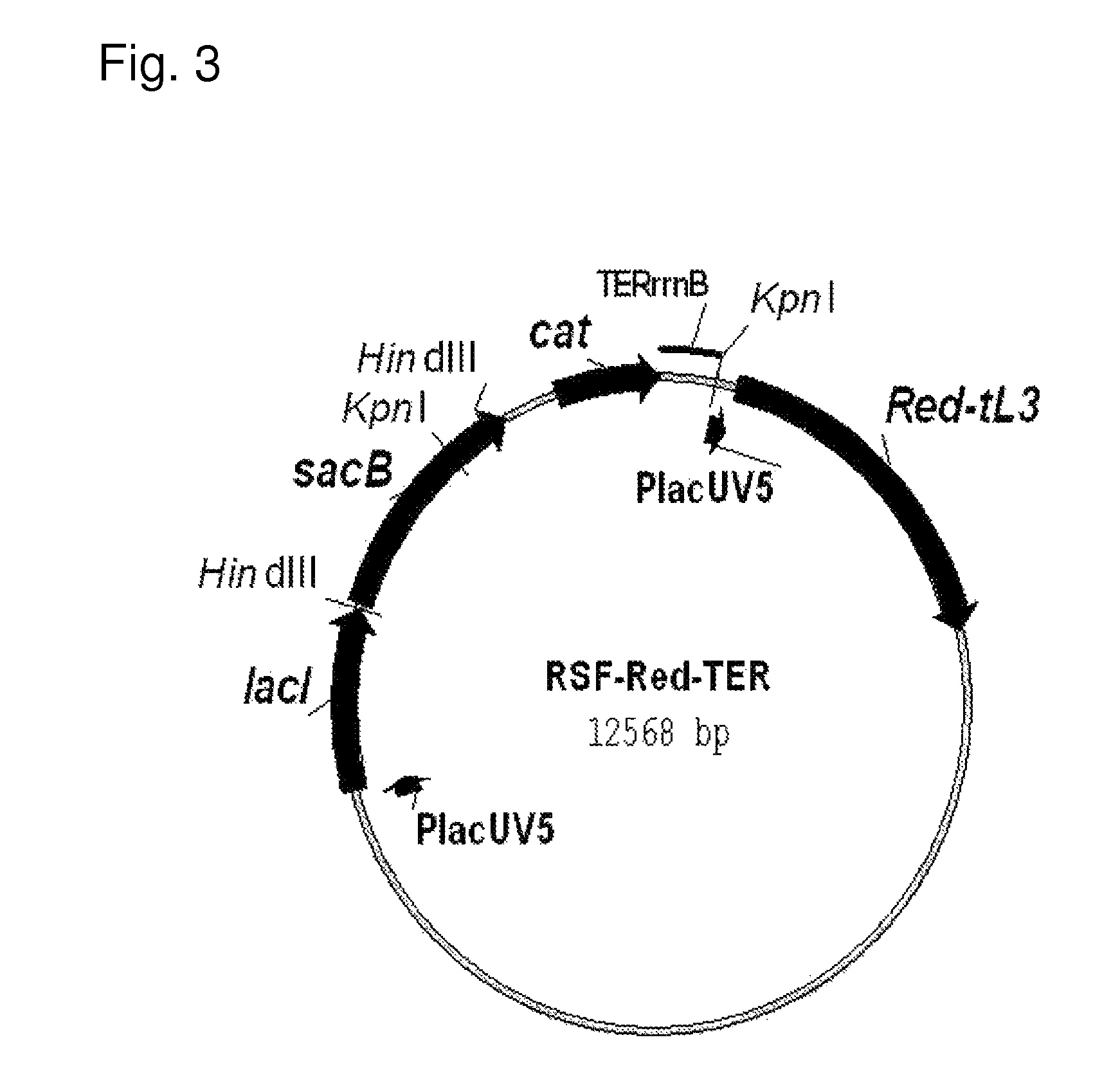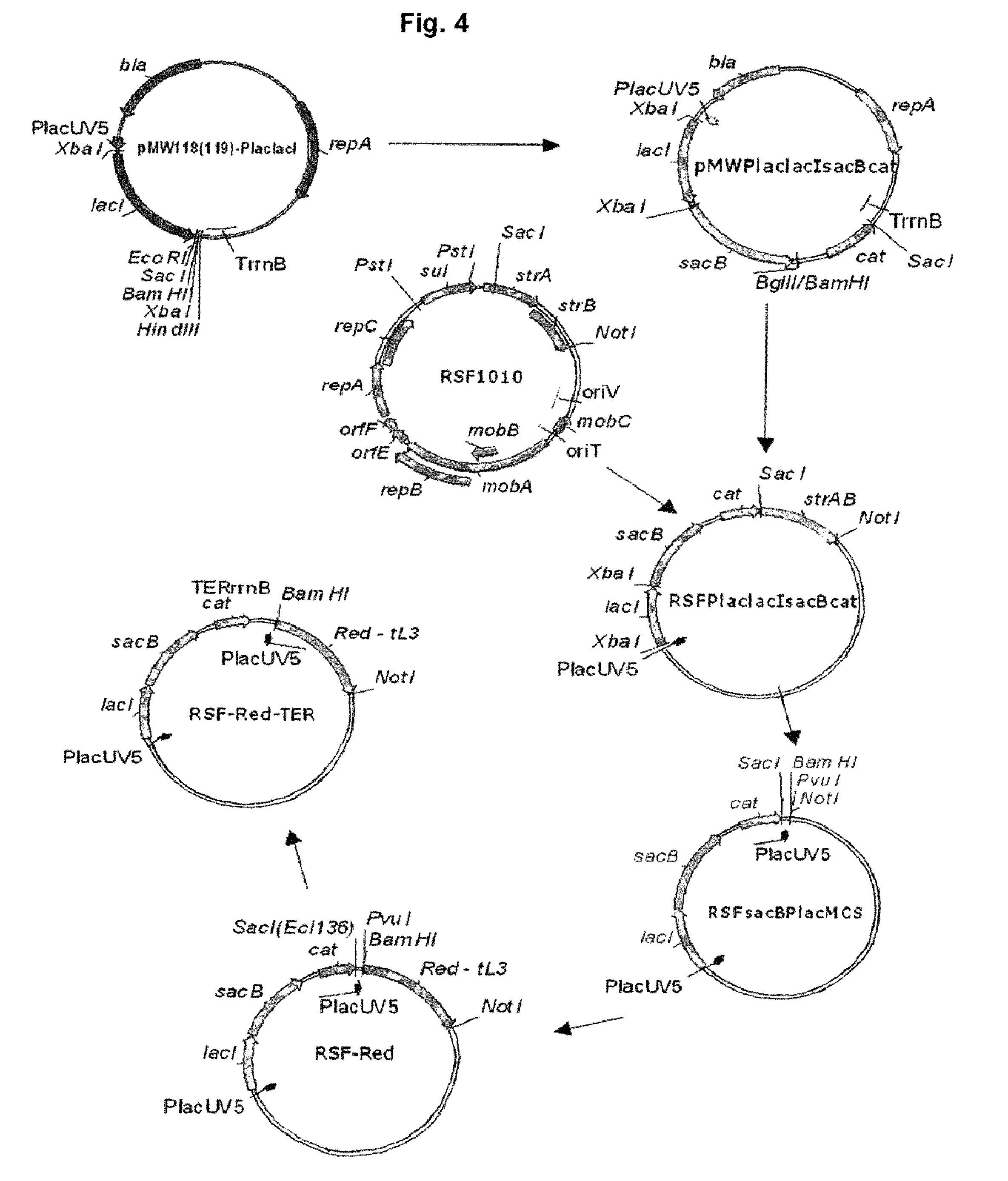Method for producing an organic acid
a technology of organic acid and production method, which is applied in the field of organic acid production method, can solve the problems of increased cost of culture medium, increased purification cost of isolating product, and low economic effect, and achieves the effect of higher yield
- Summary
- Abstract
- Description
- Claims
- Application Information
AI Technical Summary
Benefits of technology
Problems solved by technology
Method used
Image
Examples
reference example 1
Construction of L-, D-Lactate Dehydrogenase Gene-Deficient Escherichia coli Strain
[0154]This gene was deleted by using the method called “Red-driven integration” developed by Datsenko and Wanner (Datsenko, K. A. and Wanner, B. L., 2000, Proc. Natl. Acad. Sci. USA, vol. 97, No. 12, pp. 6640-6645), and the λ phage excision system (Cho, E. H., Gumport, R. I., and Gardner, J. F., 2002, J. Bacteriol., 184 (18):5200-5203). According to this method, it is possible to construct a gene-disrupted strain in a single step by using a PCR product obtained with synthetic oligonucleotide primers in which a part of the target gene is present in the 5′ end sequence and a part of an antibiotic resistance gene is present in the 3′ end sequence. Furthermore, by using the λ phage excision system in combination, the antibiotic resistance gene which is integrated into the gene-disrupted strain can be removed.
[0155] Construction of Strain Deficient in ldhA Gene Coding for D-Lactate Dehydrogenase
[0156]Accord...
example 1
Construction of yidE Gene-Enhanced Strain of Succinic Acid-Producing Bacterium
[0161] Construction of a Plasmid for Gene Amplification
[0162]In order to amplify the yidE gene, plasmid pMW219::Pthr was used. This plasmid corresponds to the vector pMW219 (Nippon Gene) which has the promoter region of the threonine operon (thrLABC) from the genome of the Escherichia coli shown in SEQ ID NO: 11 at the HindIII site and BamHI site, and enables amplification of a gene by cloning the gene at a position in the plasmid downstream from that promoter.
[0163] Construction of a Plasmid for Enhancing yidE Gene Derived from Escherichia coli
[0164]PCR was performed by using the synthetic oligonucleotide having a BamHI site shown in SEQ ID NO: 12 as a 5′ primer, the synthetic oligonucleotide having a BamHI site shown in SEQ ID NO: 19 as a 3′ primer. These primers were prepared on the basis of the nucleotide sequence of the yidE gene in the genome sequence of Escherichia coli (GenBank Accession No. U0009...
example 2
Effect of yidE Amplification
[0167] Effect of yidE Amplification in Succinic Acid-Producing Strain of Escherichia bacterium
[0168]MG1655ΔldhAΔlldD / pMW219::Pthr::yidE and MG1655ΔldhAΔlldD / pMW219 were each uniformly applied to an LB plate containing 25 μg / ml of kanamycin, and cultured at 37° C. for 16 hours. Then, each plate was incubated at 37° C. for 16 hours under anaerobic conditions by using Anaeropack (Mitsubishi Gas Chemical). The obtained cells on the plate were washed with 0.8% brine, and then diluted 51 times, and thereby a cell suspension having OD=1.0 (600 nm) was prepared. This cell suspension in a volume of 100 μl and a production medium (10 g / l of glucose, 10 g / 12Na malate, 45.88 g / l of TES, 6 g / l of Na2HPO4, 3 g / l of KH2PO4, 1 g / l of NH4Cl, adjusted to pH 7.3 with KOH and filtrated) in a volume of 1.3 ml in which dissolved gases in the medium were replaced with nitrogen gas by bubbling nitrogen gas beforehand were put into 1.5-ml volume micro tubes, and the cells were c...
PUM
| Property | Measurement | Unit |
|---|---|---|
| temperatures | aaaaa | aaaaa |
| temperatures | aaaaa | aaaaa |
| temperatures | aaaaa | aaaaa |
Abstract
Description
Claims
Application Information
 Login to View More
Login to View More - R&D
- Intellectual Property
- Life Sciences
- Materials
- Tech Scout
- Unparalleled Data Quality
- Higher Quality Content
- 60% Fewer Hallucinations
Browse by: Latest US Patents, China's latest patents, Technical Efficacy Thesaurus, Application Domain, Technology Topic, Popular Technical Reports.
© 2025 PatSnap. All rights reserved.Legal|Privacy policy|Modern Slavery Act Transparency Statement|Sitemap|About US| Contact US: help@patsnap.com



